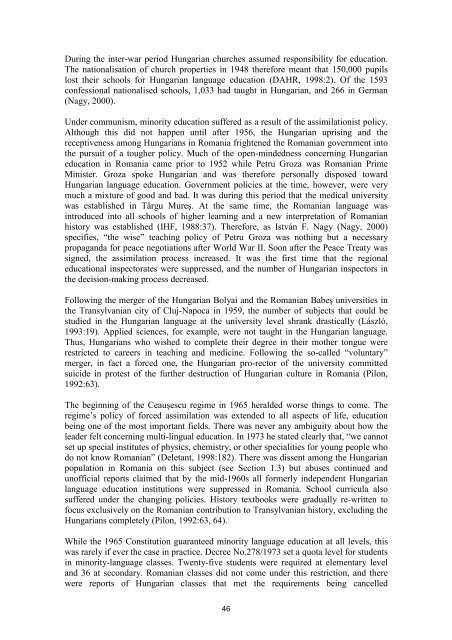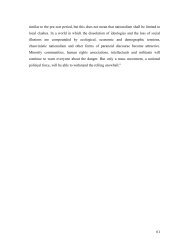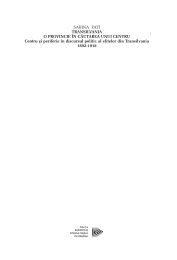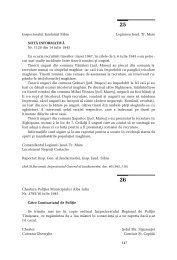Southeast Europe
Southeast Europe
Southeast Europe
You also want an ePaper? Increase the reach of your titles
YUMPU automatically turns print PDFs into web optimized ePapers that Google loves.
During the inter-war period Hungarian churches assumed responsibility for education.<br />
The nationalisation of church properties in 1948 therefore meant that 150,000 pupils<br />
lost their schools for Hungarian language education (DAHR, 1998:2). Of the 1593<br />
confessional nationalised schools, 1,033 had taught in Hungarian, and 266 in German<br />
(Nagy, 2000).<br />
Under communism, minority education suffered as a result of the assimilationist policy.<br />
Although this did not happen until after 1956, the Hungarian uprising and the<br />
receptiveness among Hungarians in Romania frightened the Romanian government into<br />
the pursuit of a tougher policy. Much of the open-mindedness concerning Hungarian<br />
education in Romania came prior to 1952 while Petru Groza was Romanian Prime<br />
Minister. Groza spoke Hungarian and was therefore personally disposed toward<br />
Hungarian language education. Government policies at the time, however, were very<br />
much a mixture of good and bad. It was during this period that the medical university<br />
was established in Târgu Mureş. At the same time, the Romanian language was<br />
introduced into all schools of higher learning and a new interpretation of Romanian<br />
history was established (IHF, 1988:37). Therefore, as István F. Nagy (Nagy, 2000)<br />
specifies, “the wise” teaching policy of Petru Groza was nothing but a necessary<br />
propaganda for peace negotiations after World War II. Soon after the Peace Treaty was<br />
signed, the assimilation process increased. It was the first time that the regional<br />
educational inspectorates were suppressed, and the number of Hungarian inspectors in<br />
the decision-making process decreased.<br />
Following the merger of the Hungarian Bolyai and the Romanian Babeş universities in<br />
the Transylvanian city of Cluj-Napoca in 1959, the number of subjects that could be<br />
studied in the Hungarian language at the university level shrank drastically (László,<br />
1993:19). Applied sciences, for example, were not taught in the Hungarian language.<br />
Thus, Hungarians who wished to complete their degree in their mother tongue were<br />
restricted to careers in teaching and medicine. Following the so-called “voluntary”<br />
merger, in fact a forced one, the Hungarian pro-rector of the university committed<br />
suicide in protest of the further destruction of Hungarian culture in Romania (Pilon,<br />
1992:63).<br />
The beginning of the Ceauşescu regime in 1965 heralded worse things to come. The<br />
regime’s policy of forced assimilation was extended to all aspects of life, education<br />
being one of the most important fields. There was never any ambiguity about how the<br />
leader felt concerning multi-lingual education. In 1973 he stated clearly that, “we cannot<br />
set up special institutes of physics, chemistry, or other specialities for young people who<br />
do not know Romanian” (Deletant, 1998:182). There was dissent among the Hungarian<br />
population in Romania on this subject (see Section 1.3) but abuses continued and<br />
unofficial reports claimed that by the mid-1960s all formerly independent Hungarian<br />
language education institutions were suppressed in Romania. School curricula also<br />
suffered under the changing policies. History textbooks were gradually re-written to<br />
focus exclusively on the Romanian contribution to Transylvanian history, excluding the<br />
Hungarians completely (Pilon, 1992:63, 64).<br />
While the 1965 Constitution guaranteed minority language education at all levels, this<br />
was rarely if ever the case in practice. Decree No.278/1973 set a quota level for students<br />
in minority-language classes. Twenty-five students were required at elementary level<br />
and 36 at secondary. Romanian classes did not come under this restriction, and there<br />
were reports of Hungarian classes that met the requirements being cancelled<br />
46









